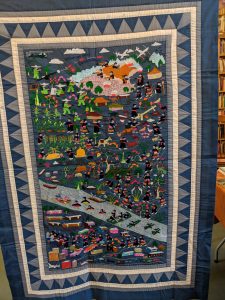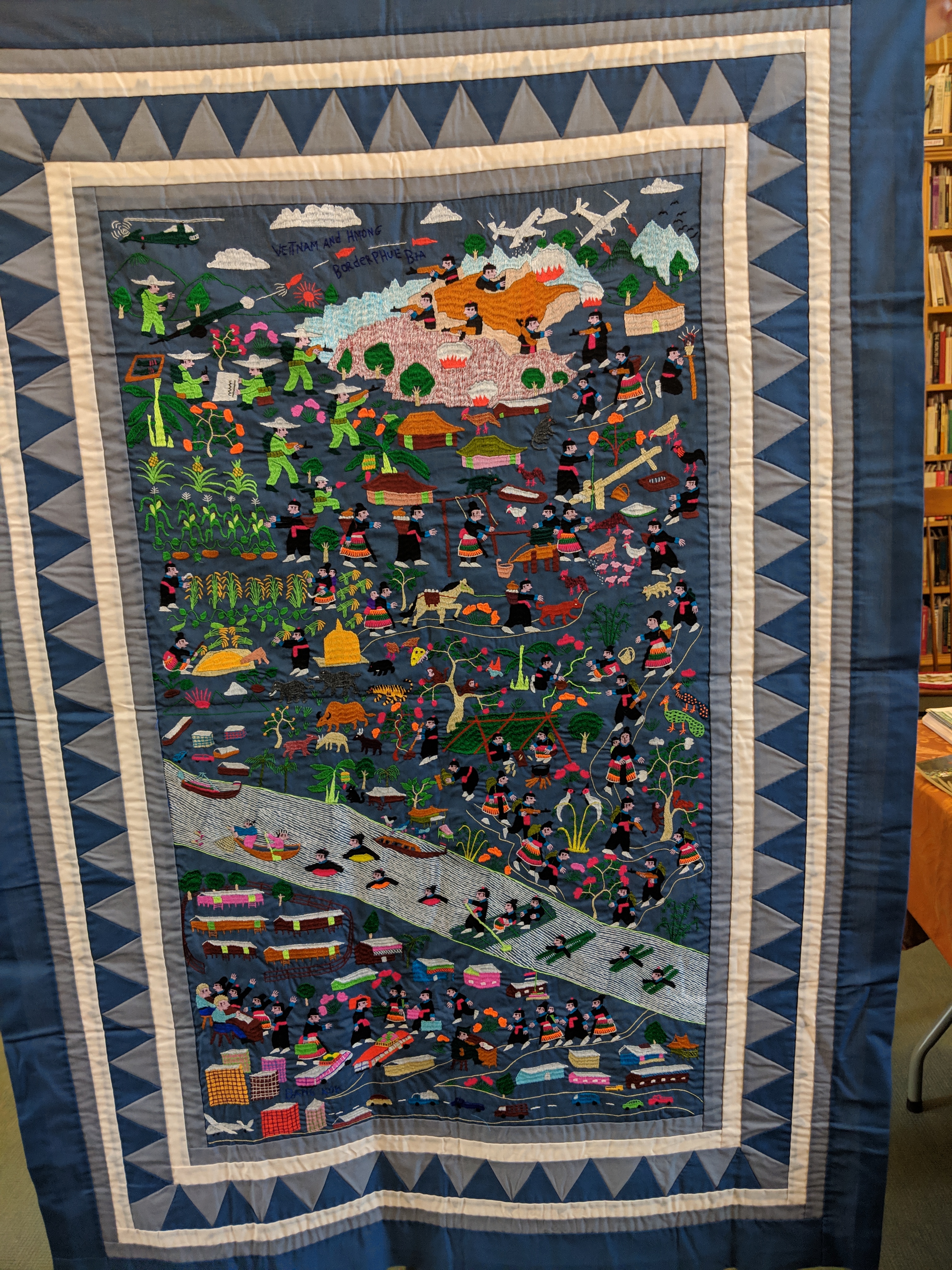Sofia Parmelee
Jonathan Goldman
HIST 290-01
Story Cloth Blog Entry
 While examining the Hmong story cloth, we identified several physical and cataloged features that illuminated the object as a primary source. First off, the cloth is the size of a blanket at 94 X 137 CM. The cloth is categorized under the “EA” category in the archives for embroidery and applique. The estimated cost for the cloth, which was purchased at a refugee camp in Thailand, was $100 back in 2002. The material of the cloth is a cotton and polyester blend consists of two parts, an overlapping triangle border which is representative of the mountains and a story cloth in the middle comprising of a complex story of immigration. The style of the cloth dates back to the 1980’s or 1990’s.The cloth still appears as if brand new and is of a high quality, even if the person who made it is unknown to us. The cloths sole purpose was to sell for revenue at a market with an intended target audience of a tourist to the refugee camp.
While examining the Hmong story cloth, we identified several physical and cataloged features that illuminated the object as a primary source. First off, the cloth is the size of a blanket at 94 X 137 CM. The cloth is categorized under the “EA” category in the archives for embroidery and applique. The estimated cost for the cloth, which was purchased at a refugee camp in Thailand, was $100 back in 2002. The material of the cloth is a cotton and polyester blend consists of two parts, an overlapping triangle border which is representative of the mountains and a story cloth in the middle comprising of a complex story of immigration. The style of the cloth dates back to the 1980’s or 1990’s.The cloth still appears as if brand new and is of a high quality, even if the person who made it is unknown to us. The cloths sole purpose was to sell for revenue at a market with an intended target audience of a tourist to the refugee camp.
The narratives visually depicted in the scenes of the cloth vary from urban to agricultural, including largely a chronicle of both Hmong involvement in the Vietnam war, as well as later displacement. The top and bottom of the cloth most heavily feature elements that tell of the Hmong refugee and wartime experience. The cloth, though, is functioning for sale at market, assuming a larger global audience to this physical object and subsequent Hmong narrative. One might then assume that this object, although historically owned and rendered by the Hmong community, is working to provide a public history, disseminating the Hmong historical reports beyond its own population.
The story cloth we considered was relatively similar to the other cloths observed inside of the library collection. The cloth did differentiate itself, however, in both size and detail. The cloth we are analyzing was about twice as big as the average cloth, and no other cloth we saw contained the full story of the Hmong people’s transition from the Vietnamese war to their swearing in ceremony in Bangkok to an image of a refugee camp along the river. Most of the other cloths told either folklore about plants or were of religious sentiment with Jesus and his disciples on the cross. One feature that a lot of the cloths had was the crossing of the river on banana boats. This was of a great significance because of how difficult the river crossing was, especially considering that many of the Hmong people, who came from the mountains, did not have the ability to swim. Many of the cloths also had images of animals in trees, including ours as well. This nature theme gets carried even further in comparison to the other cloths in how there is also the inclusion of crops, seemingly corn, in many of the cloths.
In all, our object, a Hmong story cloth, compares generally to the other objects of it’s same nature in that it is a representative piece of Hmong history, culture, and society. Although our individual cloth was focused on a more expansive timeline of specific events, other cloths chose to, as previously mentioned, render images such as the cross of Christianity. By depicting images of Christianity, for instance, one can suppose the role Christianity might play or effect the Hmong community. The cloths also, being for sale at market rather than for personal consumption alone, supplement the idea that these story cloths are a form of public history in which the Hmong are dictating their own past to a greater global public audience. The story cloths, therefore, are a great source to consider when looking at the Hmong as they provide great insight into the creation and representation of the Hmong by the Hmong people, the physical object as well as the narrative illustrated can tell us a lot about this history.

You must be logged in to post a comment.